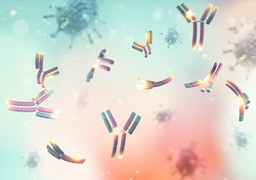High-Throughput Screening Method for Identifying Monoclonal Antibodies with Drug-Like Colloidal and Viscoelastic Properties
TECHNOLOGY NUMBER: 2019-346

OVERVIEW
A novel immunogold assay capable of screening monoclonal antibodies at variable concentrations- Co-adsorption of anti-human Fc anti IgG antibodies with lysine onto gold nanoparticles
- Promotes the discovery and engineering of therapeutic antibodies in a wide array of conditions
BACKGROUND
Monoclonal antibodies are among the most successful biopharmaceuticals because of their ability to elicit potent immune responses and treat a wide array of human diseases. The interest in using antibodies as therapeutics has led to efforts to identify antibody variants with drug-like properties at the earliest stages of discovery in order to minimize problems that may be encountered later in the development process. It is particularly important to formulate antibody therapeutics as concentrated liquid suspensions with high stability and low viscosity. However, it remains challenging during early discovery to identify antibody candidates that will possess drug-like properties when concentrated by orders of magnitude later in the development process. Anti-human antibodies are commonly attached to gold nanoparticles in these types of assays, though these nanoparticles are not stable and readily aggregate in specific pH ranges. A need exists to create assays that function across a wide range of pH values and that successfully enable evaluation of potentially therapeutic monoclonal antibodies.
INNOVATION
Researchers have developed an immunogold assay able to rapidly screening antibodies at extremely dilute concentrations while also being capable of identifying variants with favorable colloidal and viscoelastic properties when formulated at high concentrations. Their novel approach involves co-adsorption of anti-human Fc IgG antibodies with polylysine onto gold nanoparticles, following which the target human monoclonal antibodies are captured for intraparticle measurement of interactions via changes in oscillations of electron density (plasmons) of the immunogold conjugates. The polylysine both stabilizes the conjugates and increases their net positive charge, providing reliable measures of plasmon and viscosity. The assay is compatible with common histidine formulations and provides results that correlate well with dynamic light scattering measurements across a wide range of pH values. This invention will accelerate the discovery and engineering of antibodies while fostering conditions that meet the extreme requirements of highly concentrated liquid formulations.